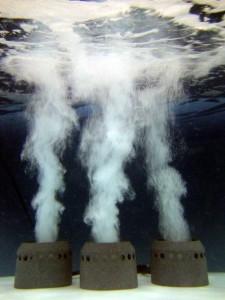Surface vs Subsurface Aeration
Surface vs Subsurface or “Bottom Up” Aeration
Aeration is the process of adding oxygen to a body of water. This is accomplished through gas exchange. The goal is to pull the air from the surrounding environment and introduce it into the water. The two main types of aeration systems are surface and subsurface or “bottom up”.
Surface Aeration Systems
Surface aeration systems work by breaking up the surface of the water and mixing it with the air above the pond. They are best used for shallower ponds with depths of less than 8 feet. They are capable of rapidly adding large amounts of oxygen to water. The limitation of surface aeration is that is primarily works on the upper depths of the pond which is why it is typically used for shallower applications.

Here, a surface aerator is used to add oxygen to a pond.
Subsurface or “Bottom Up” Aeration Systems
The deeper the pond, the better a subsurface aeration system will work. Air is pumped from a compressor through airlines to diffusers located on the bottom floor of the pond. The diffusers emit the air into the pond in the form of bubbles which come into contact with the water as they rise to the surface. A big advantage of this type of system is that air is introduced at all depths of the pond.

Subsurface or “Bottom Up” aeration systems utilize diffusers installed on the bottom floor of the pond.
Which is right for you?
Every pond is unique and therefore requires a customized approach when considering how best to aerate. We are very happy to help you analyze and offer options best suited to your pond application.
